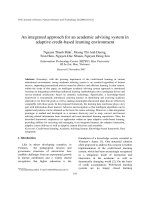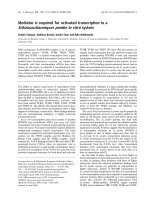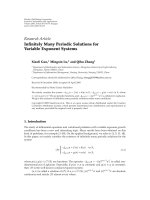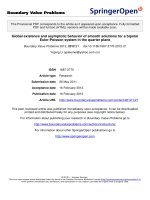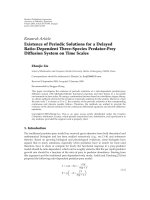Solutions for challenges in quality system implementation maintenance
Bạn đang xem bản rút gọn của tài liệu. Xem và tải ngay bản đầy đủ của tài liệu tại đây (939 KB, 41 trang )
HO CHI MINH CITY OPEN UNIVERSITY
UNIVERSITÉ LIBRE DE BRUXELLES
SOLVAY BRUSSELS SCHOOL OF
ECONOMICS & MANAGEMENT
MBQPM 6
GEORGE NGUYEN
SOLUTIONS FOR CHALLENGES IN
QUALITY SYSTEM IMPLEMENTATION
& MAINTENANCE
MASTER FINAL PROJECT
MASTER IN BUSINESS QUALITY AND PERFORMANCE MANAGEMENT
Ho Chi Minh City
Mar-2018
ABSTRACT
Challenges in quality system implementation and maintenance are analyzed
then several solutions proposed and implemented. After nine months of
solutions-implementation, the successes and failures of such solutions are
collected and further analyzed to provide further proposed remedial and
continuous-improvement actions that also align with updated company
strategies 2018-2019.
1
ACKNOWLEDGMENTS
This report is not possible without guidance and valuable advices from
professor Jacques Martin. I am also in-debt to great lectures and inspiration
by
professors
Michel
Brotto,
Pierre
Cranpazano,
and
Antigoni
Papadimitriou. I’m also grateful for my family continuous support.
2
TABLE OF CONTENT
Topic
page
Abstract
1
Acknowledgement
2
Table of Content
3
Chapter 1. Introduction
4
Chapter 2. Analysis of Issues
9
Chapter 3. Solving the issues and Implementation of solutions
24
Chapter 4. Interim evaluation of implemented solutions and
31
proposal for next step
Chapter 5. Comprehensive Conclusion
37
References
39
Definition of Terms
40
3
CHAPTER 1: INTRODUCTION :
Company profile:
CaGreen is a global company having production factories of swine
and poultry feed in Vietnam. These feed are sold to local dealers who
sell them to smaller dealers who then sell to farmers who are in
business of farming pigs, chicken, and ducks. CaGreen purchases
ingredients/materials from domestic and international suppliers; all
suppliers are managed under a supplier management system to
ensure consistent materials quality.
CaGreen has several factories strategically located in industrial zones
around Vietnam; and each factory operates independently (via an
end-to-end manufacturing process). The Quality department is
responsible for the safety, quality and regulatory compliance of
product. This department has personnel in head office and in each
factory.
Scope statement:
The project focuses on production and quality department in
relevance to two representative factories one in the South and one in
the North Vietnam out of the total eleven factories.
The southern factory is called Bien Hoa is located in Bien Hoa city,
Dong Nai province. The northern factory is called Hung Yen factory
located in Hung Yen industrial zone of same name province. Bien
4
Hoa and Hung Yen factories may sometimes be abbreviated as BH
and HY, respectively.
Of the two representative factories, most information for this final
project comes from Bien Hoa location and several references shall be
made from details of Hung Yen factory. This set-up is supported by
the fact that there is only one Quality department for all factories and
the there are more similarities than differences among them.
5
Current issues and their criticality
a) Failure or very slow to implement new Quality tasks and projects
The failure to implement Quality system tasks and project showed to
have impact onto the the QMS (Quality management system) as well as the
significant business performance and customer satisfaction impact. The
summary of the Management Review conducted on March 10th 2017 to
look back at 2016 performance is evidence for the deficiencies in the
system.
Table1. High-level Summary Management Review outcome for FY2016
Item
Internal audit
Program
Quality
training
program
Contamination
control
program
CAPA
timeliness
Rework
Date
KPI
100%
conducted
Max 2
misses, all
training
topics
completed
fully
executed
10% late less
than 2 days
and 5% late
less than 5
days
2.5% per
tonnage
10- Mar 2017
Actual
Impact
Note
Non-compliance
with Global and
regional guidelines,
risk of regulatory
15% complete audit findings
15 misses, and high risk of nonkey training
conformance/non
topics missed
compliance
Missed deadline Medium risk
Impacted on the
cost of goods sold,
25% more than defect rate,
5 days late for customer
all cases
satisfaction
5% for the last Cost of goods sold
12 months
impact
training is
followed
by excel
file
inprocess
Note: KPIs that met the targets are not included in this list
6
b) Quality system maintenance issue: documentation, verification
mechanism, training program, etc. are not consistent despite best
efforts. Besides the the issues which were shown in from the
Management Review the document control issue is omni present in
Non conformity details found in cases of using wrong form, using outdated work instruction and SOP, there are procedures not updated to
reflect current practice
c) High defect rate: wrong ingredients, defective finished goods, etc.
in production are not under reasonable control. This third issue
generally related to defect rate within the production processes from
pre-mixing and weighing of ingredients to the in process mixing of
proper ingredient bins to the final mixing and packaging. Even though
the defects are detected based on final product testing however
defect rate negatively impacts the Cost of Goods Sold and ultimately
has an impact on customer satisfaction. The defect issue will further
be analyzed in chapter 2.
7
The flowchart of this report
Chapter 1.
Introduction of the
issues
Chapter 2. Analysis of
the issues
Chapter 3. Solving the
issues and implementation
of solutions
Chapter 4. Interim evaluation of
result data after implementation &
proposal for next steps
Chapter 5. Comprehensive
conclusion
8
CHAPTER 2: DATA ANALYTICS AND INVESTIGATION OF THREE
ISSUES :
1) Data and analysis of the failure to implement the Quality System
elements
The failure in several implementation of quality program were
addressed during Management Review and followed up after management
review. Individuals were identified to take ownership of these failures so that
they could further investigate the root cause and come up with resolutions.
As part of this Final Project, I was involved with one follow-up in terms of
data collection, identification of the key affecting factors and root causes,
discussions and solutions implementation for the internal audit program
implementation.
Before providing further details of the internal audit program requirements
given by regional offices of CaGreen, below is introduction of what such
audit program entails:
Food Safety Internal Audit program:
1) Mandatory audits that are conducted yearly to all factory to ensure
compliance with regulations, standards, and policies on food safety
2) The audit checklist is comprehensive and inclusive of below
standards:
a) ISO 22000 Food Safety system also known as HACCP
b) PAS 222 Publicly available System on food safety
c) Corporate requirements: special requirements for all facility
based on business risk and current strategy
d) Regulatory requirements by the Ministry of Agriculture and
Rural Development (MARD)
9
3) The Performance evaluation of Operations and Quality is based on
both
a) Completion of the audits at all factories
b) Remedial actions for the all of the nonconformities discovered
during the audits.
c) External assessment by regional team to verify effectiveness of
the corrective and preventive actions
The first set of data come from update of the audit results in Table 2.
Table 2. Internal Quality Audit updated 10 Mar 2017
(Fiscal year 2016: Jun 2016 to May 2017)
Binh
Factory
Bien Hoa
Can Tho
Long An
Dinh
Hung
Nghe An
Sep-
Yen
Ha Nam
Jan
Aug-2016
none
none
2016
Oct-2016
2017
Feb 2017
109
na
na
87
67
105
95
56
na
na
25
65
45
72
completion
51%
na
na
29%
97%
43%
76%
Target
80%
80%
80%
80%
80%
80%
80%
Audit date
Total
findings
Items
corrected
%
Problem definition:
This audit program is the single most important program in Quality
department as well as in Operations and other cross-functional
departments such as Customer Service, Purchasing, and marking.
This audit program is the major indication of how well all aspect of
10
Quality system especially system relevant to day-to-day operations
are performing and also reflective of compliance with corporate and
regional requirements.
So the problem is: failure to implement 100% audits to all facility and
failure to ensure all non-conformities from audit finding are addressed
in a timely manner for all factories.
Finding the root cause:
Without having to resource to SWOT of the department or looking
further into the past for testimonies and personal anecdotes the team
and I dived right in to the Ishikawa tool to find the root cause or
causes.
Figure 1
MANAGEMENT
Lack of Leadership
follow-up and
commitment
METHOD
Procedure for
program
implementation
MAN
No clear
responsibilities
defined for
personnel
Resources
No dashboard
The network of
similar factories
does not yet
promote mual
ENVIRONMENT
Lack user-friendly
software to support
audit and reminders
Failure
to
execute
audit
program
Complicated audit
checklist
MATERIALS
MANCHINE
11
We further deep-dived into the Man and Method aspect as they came out
strongest for the fishbone exercise by using 5-Why method
1. Why did we fail the implementation of audit program?
a. Because there’s no follow-up mechanism, no reporting routine
in place, no person assigned the full responsibilities, the person
who was in charge left the company
2. Why didn’t we have follow-up mechanism, sufficient human
resources, full assignment of tasks to individuals
a. Because there have not been strong commitment by leadership
to add manpower at headquarters as well as at individual
factories. Also, there’s no procedure in place to ensure a
stepwise process is effective to guide all relevant personnel.
3. Why didn’t we have strong commitment from leadership and individual
factories and why were there no procedures on place?
a. Because Regional leader failed to communicate the importance
of such implementation and how it could impact the business
negatively and because there was not a request to formulate
the strategy to Vietnam from Regional office.
4. Why didn’t Regional office communicate the strategy properly to local
Vietnam factories
a. It’s oversight and also lack of resources. One regional manager
had to handle too many countries
b. Local Vietnam leadership was not fully aware of the content,
importance, impact of such audit program (not yet in KPI)
Devising the possible solutions;
Several meetings have been held locally within leadership of Vietnam
factories to address the newly found root causes of lacking of regional
support and so we come up with the following solutions:
12
1) Training for plant managers and supervisor on the quality program
including the importance of quality audit and the criticality of audit
finding corrections
2) Input KPI (to be shown later in the Implementation of solution along
with other quality objectives and targets) for the audit program: actual
audit and remedial actions
3) Input into budget a quality lead for each factory; this is a very
ambitious request due to it has substantial financial impact into
operations. This quality lead person will coordinate all efforts related
to implementation of strategic activities such as audit plan, audit
execution, follow-up on remedial actions and so forth.
2) Data and analysis of Quality System maintenance issue
The second issue as part of the final project is the insufficient
maintenance of the quality system in terms of document control, inspection
program, training program
13
Table 3. System maintenance issue summary at BH
Area
Finding
45%
Document procedures
Control
not updated
timely
Non-conformity
Details
Note
There are 67 internal
DC Procedure not audit findings related
have form for
Doc Control: wrong
records retention
forms, inaccurate info
na
in WI
Corporate & regional
Training program
Training
procedures, updates,
No training
No approved for newcomers
and requirements are plan
Training plan missing several
not part of regular
defined for
refresh GMP/HACCP
contractors
key procedures
training
No procedure in
Routine
checking/in
spection
No defined
place to ensure
plan for
check on routine
manager/lea tasks such as
der to check verification of
on routine
record retention
tasks
period or correct
na
na
form version
Finding the root cause:
As requirement for any audits, the teams were supposed to have
discussions to remedy these issues but such meeting and follow-up were
not adequately addressed. As part of this final project, the Document control
was selected as targeted improvement for this second problem of
14
maintenance of the Quality management system. See table 4 below for how
Risk Assessment is used to identify the priorities of the Document control
issues that have higher priority.
Table 4. Data analysis of the DOCUMENT CONTROL issue with Risk Assessment
No.
Item
1 Using incorrect form
2
Lacking the proper procedures
for key processes
Occuren Severit Detectabi
Risk
Priority
ce (1-5)
y (1-5)
lity (1-5)
2
5
4
40
3
3
1
9
1
5
3
15
3
3
4
36
2
5
2
20
Number
New/Revised SOP, WI (Work
3 Instruction) not issued to
respective departments
The review cycle not respected
4 with more than 20% procedures
past regular review timeline
Signature authority not 100%
5
established to ensure the right
persons can review/approve
document
Further documented interviews to the relevant Operations and Quality staff
revealed that the training on document control is not yet part of the yearly
GMP training. Also there was incidents of records loss or not communicated
to the proper departments.
15
3) Data and analysis of defect rate and top defects
The third issue being part of this final project is to address the defect
rates with a focus on the top 3 defects. Each top defect will eventually
be input into the Pareto chart to identify the influencing factors. This
quality tool was found effective and convincing to the team. The
defects data presented here are from two factories only and for their
main production process: livestock feeds. Other seven (7) factories
experienced similar challenges and would received similar solution
implementation. Lastly, the further analysis of defect issue is done for
Bien Hoa only with the assumption that due to having same
machinery and similar operations processes, the problem can be
translational from Bien Hoa as representative for south factories to
Hung Yen as representative for North factories.
On a further note, for deviation classified per internal procedure as
non-conformity and triggers a process similar to 8D Process: building
of a team, problem definition, containment and bracketing actions,
root cause analysis, Corrective and Preventive Action implementation,
verification of the effectiveness of these actions, Result sharing with
team.
16
Table 5. Defect rate in past 4 quarters before the Management Review
Bien Hoa - Quantity
defect (livestock only)
High Mois
Jan-Mar
Apr-Jun
Jul-Sep
Oct-Dec
2016
2016
2016
2016
YTD
2257
2415
2212
2370
9254
57
61
56
60
234
117
125
115
123
480
32
34
31
34
131
Fine
1330
1423
1303
1397
5453
Size
1102
1179
1080
1157
4518
Color
128
137
125
134
525
Others
576
616
564
605
2362
5599
5991
5487
5879
22956
455,000
375,000
398,234
1.23%
1.60%
1.38%
1.39%
1.39%
0.55%
0.71%
0.61%
0.62%
0.62%
Mixed others
PDI
Nutrition
Total
MT produced (tonnes)
% Defect
% Top 3 defect (High
Mois, Fine, Size)
Hung Yen-Quality
defect (livestock only)
High Mois
Mixed others
PDI
Nutrition
421,450 1,649,684
Jan-Mar
Apr-Jun
Jul-Sep
Oct-Dec
2016
2016
2016
2016
YTD
1945
1809
1887
2003.35
7644
372
346
361
383.16
1462
25
23
24
25.75
98
527
490
511
542.81
2071
17
Fine
1036
963
1005
1067.08
4071
Size
957
890
928
985.71
3761
Color
73
68
71
75.19
287
Others
471
438
457
485.13
1851
5406
5028
5244
5568.18
21246
305,343
327,421
375328
365,987
1374079
1.77%
1.54%
1.40%
1.52%
1.55%
1.29%
1.12%
1.02%
1.11%
1.13%
Total
MT produced (tonnes)
% Defect
% Top 3 defect (High
Mois, Fine, Size)
Note: all defects are detected and removed from production or from finished
goods stock; this ensures all released products are in full compliance with
customer's specifications and regulatory requirements
From the comprehensive data in Table 5, the defect rate in
percentage, calculated as tonnage of defects per overall production
for that same period. The defect rate hoovers around 1.5% which is
higher than the Gold standard 0.5%
18
Figure 2. Bien Hoa Factory Defect rate for 2016
Figure 3. Hung Yen Factory Defect rate for 2016
19
Finding the root cause:
For the final project, the Bien Hoa factory data were used for further analysis
to identify the influencing factors contributing to the three major defects High
moisture, Fine, and Size. Please see below for defect definitions
TOP 3 DEFECTS DEFINITION
High moisture: when product moisture is above the 12%
specifications
Fine: there is a 2% limit for fine within for finished goods. Fines are
small particles of product that are usually caused by frictions such as
grinding or moving through pipes and silos
Size: the standard size for feed product in pellets is 90% with 9.5mm
+/- 2mm in length, any size different than that is considered defect.
Preliminary discussions with commercial team, management, and customer
service team resulted in that the focus should be more on High moisture and
Fine. These two will have the most impact going forward. Especially for the
high moisture problem which usually leads to complaint on mite
development at customer site. Below Figure 4 indicate number of
complaints based on production date
20
a) Finding root cause for High moisture issue & solution proposals:
There are factors influencing the resulting high moisture at finished goods
such as; incoming raw materials, equipment, and human error during
production. Pareto chart was used to identify the top factors as seen in
Table 6 below:
Table 6. Pareto Analysis of defect factors High Moisture at BH Feb-2016 to Jan2017
Defect factors
Number of Defects
Cumulative Percentage
Raw materials
45
31%
environment
34
54%
Water adjustment
22
69%
Intake air from
21
Temperature fluctuation
11
77%
Equipment issue
8
82%
Human error
7
87%
SKU
6
91%
Ingredients interaction
5
95%
Packing materials
5
98%
All Others
3
100%
Cooling time for each
Top three factors accounted for nearly 70% high-moisture defects are: raw
materials (mainly corn and wheat), humid air taken from environment to cool
22
the in-process products, and water volume being added to compensate for
water loss during heating and drying. In Table 7, investigation into these 3
issues based QC Lab data, complaint rate, finished goods inspection. Also
linked to the internal audit issue that several defects were not escalated into
the corrective action-preventive action (CAPA) mechanism; a stronger
system of handling non-conformity implementation and follow-up of CAPA.
This deficit will be further discussed in the Chapter 5 Conclusion
23
CHAPTER 3: SOLUTIONS IMPLEMENTATION:
3.1 Solution implementation for the Failure to implement the Quality System
elements issue:
As previously discussed in Chapter 2 on the potential solution to address
challenges in Quality System implementation. The following were proposed
and accepted by Regional lead of Quality, head of Operations, and QA
Manger as of Apr 2017.
a) External training class on ISO 22000 auditor by British
Standard Institute (BSI) for all factory managers and supervisor,
Customer Service Managers and Supervisor, QA QC leaders,
and selected senior staff
b) Established a Quality committee within each factory with the
main coordinator is fully responsible for distribution of
standardization information, follow-up with outstanding items,
report of issue to upper management. This coordinator is called
Quality Lead who report directly to the QA Manager. This is a
major milestone in terms of dedicated resources and from the
external perspective a stepping stone to send the foundation for
standardization and systematic improvement.
c) Internal audit program procedure to be written with full-year
audit plan established and auditors defined.
These three key solutions also aim to address the issue with failure of
the Internal Audit Program whose checklist is very well-defined from
corporate level. The goal is to ensure timely conducts of these internal
audit with knowledge gained from the official training facility and with
the Quality Lead who ensures the outcomes of such audit are
addressed at facility’s department level.
24



